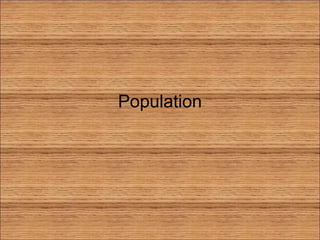
Population (world geog unit 4)
- 1. Population
- 2. Where is the world’s population distributed?
- 3. I Where are the people A. People are not evenly distributed. Half live in cities (URBAN), the other half in rural areas. B. Ninety percent live on 20% of land,and half live on only 5% of the land. Humans occupy only a small portion of the land on earth. C. There are four generalizations when it comes to how population is distributed around our planet.
- 4. 1. Ninety percent live north of the Equator and 2/3 of people live in the mid-latitudes. 2. People live in low elevations. Between 50- 60% of the population lives below 1,000 ft. and nearly 80% live below 1650 ft. 3. People live near the coasts. Two-thirds of all people live within 300 miles of an ocean. 4. People live near fertile land along rivers.
- 5. II 4 Areas of Large Populations A East Asia, including Japan, China, Korea, Taiwan. 25% of people on earth. B South Asia, including India, Pakistan, Bangladesh and Sri Lanka. 21%. C Europe contains another 12%. D Northeast USA and Southeast Canada. E Other notable areas include Egypt, Java, the S.E. South American coast and parts of Africa.
- 7. III Ecumene A. The ecumene is the part of the world that is permanently inhabited. B. People locally extend the ecumene through irrigation, terracing fields, etc. C. Nonecumene is the uninhabited or sparsely occupied areas of the earth. D. Thirty-five to 40% of all land does not have any significant human settlement.
- 8. IV Non-Ecumene A. Dry Lands 1. Major deserts include the Sahara, Arabian, Thar, Taklimakan, Gobi, Atacama, S.W. USA, and much of Australia B. Wet Lands 1. Amazon basin, Congo Basin, and along the Equator C. Cold Lands 1. Polar Regions D. High Lands 1. Major Mountain ranges include Rockies, Alps, Himalayas, and Andes
- 9. V Population Density A. Population density is the relationship between the number of inhabitants and the area they occupy. B. There are three types of density figures that geographers look at
- 10. 1. Crude density or Arithmetic density. This is the number of people per unit of land. This is easy to obtain, though it is only an average of total land, and often does not give a proper image of a place. 2. Physiological density is the number of people divided by the arable land (land that is good for farming). 3. Agricultural density only takes into account rural residents and arable land (how many farmers per unit of arable land).
- 11. China Population Case Study • Arithmetic density 350 people/square mile • physiological density 3,500 people/square mile. • Only 10% of China is cultivable, and 80% of the population lives on this land. • Distribution: western 2/3s of China (mostly minorities) is sparsely populated. • Why?
- 13. Where has the world’s population increased?
- 14. I Birth Rates A. CBR = Crude Birth Rate. How many babies are born for every 1000 people. B.TFR= Total Fertility Rate. How many babies the average woman of a country could expect to have. This gives a better idea of reproduction rates. 1. TFR of 2.1 to 2.3 is the replacement level of fertility.
- 16. II Death Rates A. CDR= Crude Death Rate. Also called mortality rate. It is measured in deaths per 1000 people B. Pre WWII, death rates were much higher in developing countries than developed countries. Post WWII, that is not true because of the development of modern medicines and health information. C. Life expectancy is what age you can expect to live to. In developing countries CDR has gone down while life expectancy has gone up. D. Countries with high AIDS rates are the exception.
- 18. III Natural Increase A. Rate of Natural Increase shows rate of population growth without factoring in migration B. It is figured by starting with birth rate and subtracting the death rate. It is usually shown as a percentage. Example: CB is 22 and CD is 12. 22-12=10. Natural increase would be 1% (of 1000).
- 20. IV Doubling Times A. Doubling time is the time it would take for a population to double at the current natural increase rate. B. Populations grow exponentially rather than arithmetically. This is sometimes called a J-curve. C. Doubling time predictions are almost never accurate because so much can change in a population over time. Immigration and emigration rates change as does life expectancy and social policies or practices.
